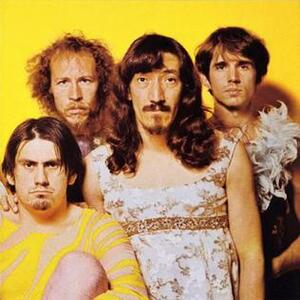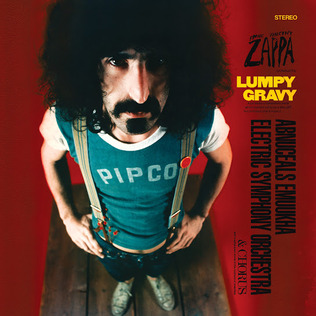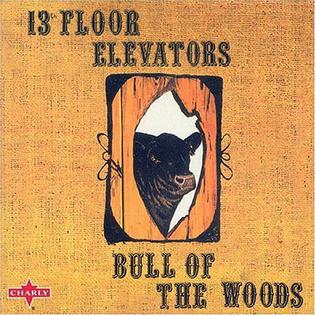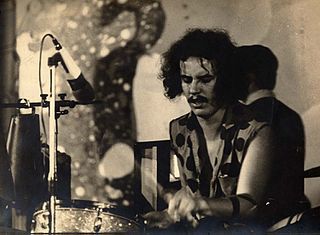Related Research Articles

Frank Vincent Zappa was an American musician, composer, and bandleader. In a career spanning more than 30 years, Zappa composed rock, pop, jazz, jazz fusion, orchestral and musique concrète works; he also produced almost all of the 60-plus albums that he released with his band the Mothers of Invention and as a solo artist. His work is characterized by nonconformity, improvisation sound experimentation, musical virtuosity and satire of American culture. Zappa also directed feature-length films and music videos, and designed album covers. He is considered one of the most innovative and stylistically diverse musicians of his generation.

Psychedelia usually refers to a style or aesthetic that is resembled in the psychedelic subculture of the 1960s and the psychedelic experience produced by certain psychoactive substances. This includes psychedelic art, psychedelic music and style of dress during that era. This was primarily generated by people who used psychedelic drugs such as LSD, mescaline and psilocybin and also non-users who were participants and aficionados of this subculture. Psychedelic art and music typically recreate or reflect the experience of altered consciousness. Psychedelic art uses highly distorted, surreal visuals, bright colors and full spectrums and animation to evoke, convey, or enhance the psychedelic experience. Psychedelic music uses distorted electric guitar, Indian music elements such as the sitar, tabla, electronic effects, sound effects and reverb, and elaborate studio effects, such as playing tapes backwards or panning the music from one side to another.

The 13th Floor Elevators was an American rock band from Austin, Texas, United States, formed by guitarist and vocalist Roky Erickson, electric jug player Tommy Hall, and guitarist Stacy Sutherland. The band was together from 1965 to 1969, and during that period released four albums and seven singles for the International Artists record label.

We're Only in It for the Money is the third album by American rock band the Mothers of Invention, released on March 4, 1968, by Verve Records. As with the band's first two efforts, it is a concept album, and satirizes left- and right-wing politics, particularly the hippie subculture, as well as the Beatles' album Sgt. Pepper's Lonely Hearts Club Band. It was conceived as part of a project called No Commercial Potential, which produced three other albums: Lumpy Gravy, Cruising with Ruben & the Jets, and Uncle Meat.

Jazz fusion is a popular music genre that developed in the late 1960s when musicians combined jazz harmony and improvisation with rock music, funk, and rhythm and blues. Electric guitars, amplifiers, and keyboards that were popular in rock and roll started to be used by jazz musicians, particularly those who had grown up listening to rock and roll.

Lenny Kaye is an American guitarist, composer, and writer who is best known as a member of the Patti Smith Group, led by vocalist and poet Patti Smith.

The Fugs are an American rock band formed in New York City in late 1964, by the poets Ed Sanders and Tuli Kupferberg, with Ken Weaver on drums. Soon afterward, they were joined by Peter Stampfel and Steve Weber of The Holy Modal Rounders. Kupferberg named the band from a euphemism for fuck used in Norman Mailer's novel The Naked and the Dead.

Civilization Phaze III is the sixty-third album by Frank Zappa, released posthumously as a double album on October 31, 1994. It was the first studio album of new material from Zappa since 1986's Jazz from Hell. The album marks the third part of a conceptual continuity that started with We're Only in It for the Money (1968), with the second part being a re-edited version of Zappa's 1967 album Lumpy Gravy. Zappa described the album as a "two-act opera", but in lieu of traditional recitatives and arias, it alternates brief spoken word passages with musical numbers created on a Synclavier using a combination of sampled and synthesized sounds. Much of the sampled material in the second half of the album was originally recorded by Ensemble Modern and other musicians to Zappa's specifications.

Lumpy Gravy is a 1968 solo album by Frank Zappa, written by Zappa and performed by a group of session players he dubbed the Abnuceals Emuukha Electric Symphony Orchestra & Chorus. Zappa conducted the orchestra but did not perform on the album. It is his fourth album overall: his previous releases had been under the name of his group, the Mothers of Invention.

Gary D. Davis, known as Reverend Gary Davis and Blind Gary Davis, was a blues and gospel singer who was also proficient on the banjo, guitar and harmonica. Born in Laurens, South Carolina and blind since infancy, Davis first performed professionally in the Piedmont blues scene of Durham, North Carolina in the 1930s, then converted to Christianity and became a minister. After moving to New York in the 1940s, Davis experienced a career rebirth as part of the American folk music revival that peaked during the 1960s. Davis' most notable recordings include "Samson and Delilah" and "Death Don't Have No Mercy".

Bull of the Woods is the third studio album by The 13th Floor Elevators, and the last on which they worked as a group. The album is noted for its moody, dreamy, and fuzzed-out psychedelic sound, and was released by International Artists.

Crown of Creation is the fourth studio album by the San Francisco psychedelic rock band Jefferson Airplane, released by RCA Victor in August 1968. The album saw the band continuing their development of psychedelic music, emphasizing acid rock with science fiction themes.
Anthony Carmine Bongiovi Jr is an American record producer and recording engineer. He is the cousin of musician Jon Bon Jovi.

The Record Plant is a recording studio established in New York City in 1968 and currently operating in Los Angeles, California. Known for innovations in the recording artists' workspace, it has produced highly influential albums, including the New York Dolls' New York Dolls, Bruce Springsteen's Born To Run, Blondie's Parallel Lines, Metallica's Load and Reload, the Eagles' Hotel California, Fleetwood Mac's Rumours, Eminem's The Marshall Mathers LP, Guns N' Roses' Appetite for Destruction, and Kanye West's The College Dropout. More recent albums with songs recorded at Record Plant include Lady Gaga's ARTPOP, D'Angelo's Black Messiah, Justin Bieber's Purpose, Beyoncé's Lemonade, and Ariana Grande's Thank U, Next.

Arthur Dyer Tripp III is an American retired musician who is best known for his work as a percussionist with Frank Zappa and the Mothers of Invention and Captain Beefheart and his Magic Band during the 1960s and 1970s. Thereafter, Tripp retired from music. He attended an accredited chiropractic college in Los Angeles from 1980 through 1983, graduating with his Doctor of Chiropractic degree. He currently practices in Gulfport, Mississippi.

Gary Kellgren was an American audio engineer and co-founder of The Record Plant recording studios, along with businessman Chris Stone.
Bunky and Jake were an American folk rock duo, who were a part of the New York folk music scene in the 1960s and 1970s. They merged folk, rock, R&B and blues. They are influenced heavily from the 50s classic pop and rock, such as Nolan Strong and the Diablos, the Crows, Dion and the Belmonts, the Mystics and the Passions.
John Townley is a musician, astrologer, and naval historian who was a member of the folk-rock group The Magicians and founder of New York City's Apostolic Recording Studio. Townley performs and releases maritime music, and is a professional astrologer who has published eight books on the subject.

Tenderness Junction is the fourth studio album of The Fugs, formed in 1964 by anti-war musician/poets Ed Sanders, Tuli Kupferberg and Ken Weaver. It was released in the US by record company Reprise. A stand-alone CD was released by Wounded Bird Records in 2011, before which the entire album had appeared on the 2006 3-CD Rhino Handmade box set, Electromagnetic Steamboat.

Songs of Innocence and Experience is an album by American beat poet and writer Allen Ginsberg, recorded in 1969. For the recording, Ginsberg sang pieces from 18th-century English poet William Blake's illustrated poetry collection of the same name and set them to a folk-based instrumental idiom, featuring simple melodies and accompaniment performed with a host of jazz musicians. Among the album's contributors were trumpeter Don Cherry, arranger/pianist Bob Dorough, multi-instrumentalist Jon Sholle, drummer Elvin Jones, and Peter Orlovsky – Ginsberg's life-partner and fellow poet – who contributed vocals and helped produce the recording with British underground writer Barry Miles.
References
- 1 2 3 "1968 API 550A Equalizer". mixonline.com. Future plc. 28 August 2008. Retrieved 7 July 2022.
- 1 2 3 4 Breznikar, Klemen (10 March 2021). "'Ocean', A Lost Recording Of The Family Of Apostolic - John Townley Interview". It's Psychedelic Baby! Magazine . Retrieved 30 June 2022.
- 1 2 Bubbins, Harry (18 December 2019). "Why Isn't This Landmarked? 53 East 10th Street, Home of Apostolic Studios". villagepreservation.org. Village Preservation. Retrieved 7 July 2022.
- ↑ Abbott, Jim (29 January 1990). "Memories of Frank in the '60s". orlandosentinel.com. Orlando Sentinel. Retrieved 7 July 2022.
- ↑ Benbenek, Kurt (14 May 2007). "Questions and Answers with John Townley". astrococktail.com. John Townley. Retrieved 30 June 2022.
- ↑ Zack, Ian (2015). Say No to the Devil: The Life and Musical Genius of Rev. Gary Davis. Chicago, United States: University of Chicago Press. p. 235. ISBN 978-0-226-23410-6.
- ↑ Perlich, Tim (30 May 2012). "Whaddya mean you don't know George & Ben". baltimoreorless.com. Retrieved 7 July 2022.
- ↑ Zack, Ian (2015). Say No to the Devil: The Life and Musical Genius of Rev. Gary Davis. Chicago, United States: University of Chicago Press. p. 235. ISBN 978-0-226-23410-6.
- ↑ "McCune Studios Open on Coast" (PDF). Billboard. Billboard. 9 November 1968. p. 77. Retrieved 30 June 2022.
- ↑ Jennings, Steve (1 October 2022). "New York '77". MIX. Future plc. Retrieved 30 June 2022.